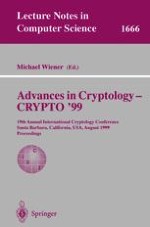Crypto ’99, the Nineteenth Annual Crypto Conference, was sponsored by the International Association for Cryptologic Research (IACR), in cooperation with the IEEE Computer Society Technical Committee on Security and Privacy and the Computer Science Department, University of California, Santa Barbara (UCSB). The General Chair, Donald Beaver, was responsible for local organization and registration. The Program Committee considered 167 papers and selected 38 for presentation. This year’s conference program also included two invited lectures. I was pleased to include in the program UeliM aurer’s presentation “Information Theoretic Cryptography” and Martin Hellman’s presentation “The Evolution of Public Key Cryptography.” The program also incorporated the traditional Rump Session for informal short presentations of new results, run by Stuart Haber. These proceedings include the revised versions of the 38 papers accepted by the Program Committee. These papers were selected from all the submissions to the conference based on originality, quality, and relevance to the field of cryptology. Revisions were not checked, and the authors bear full responsibility for the contents of their papers.
